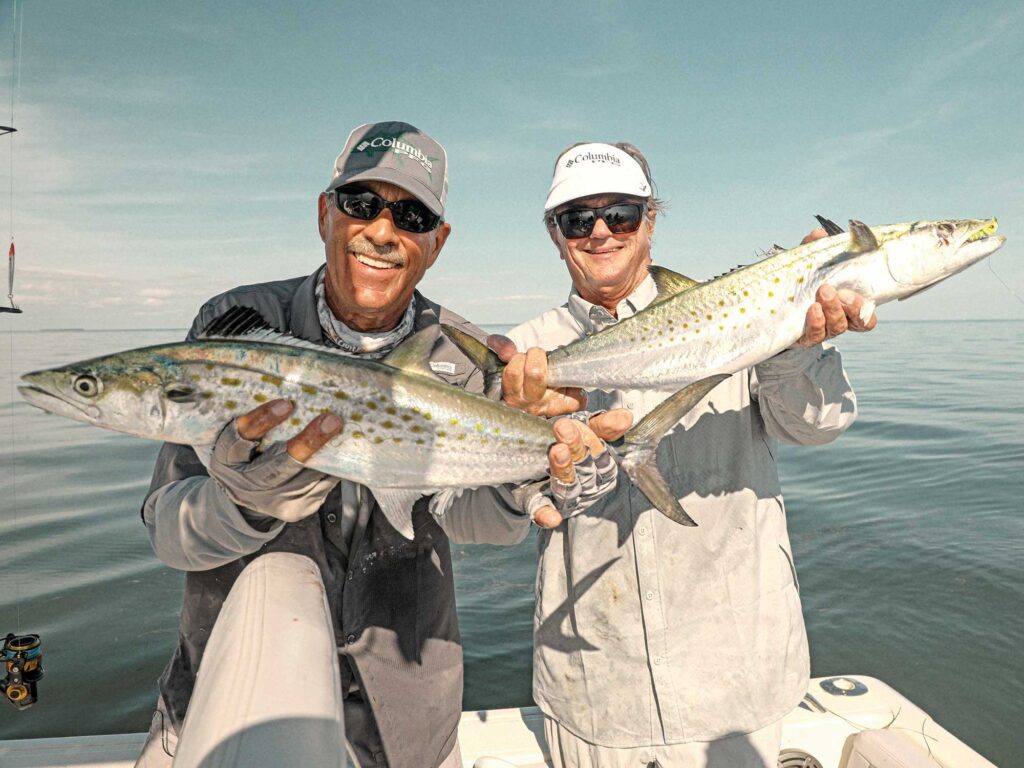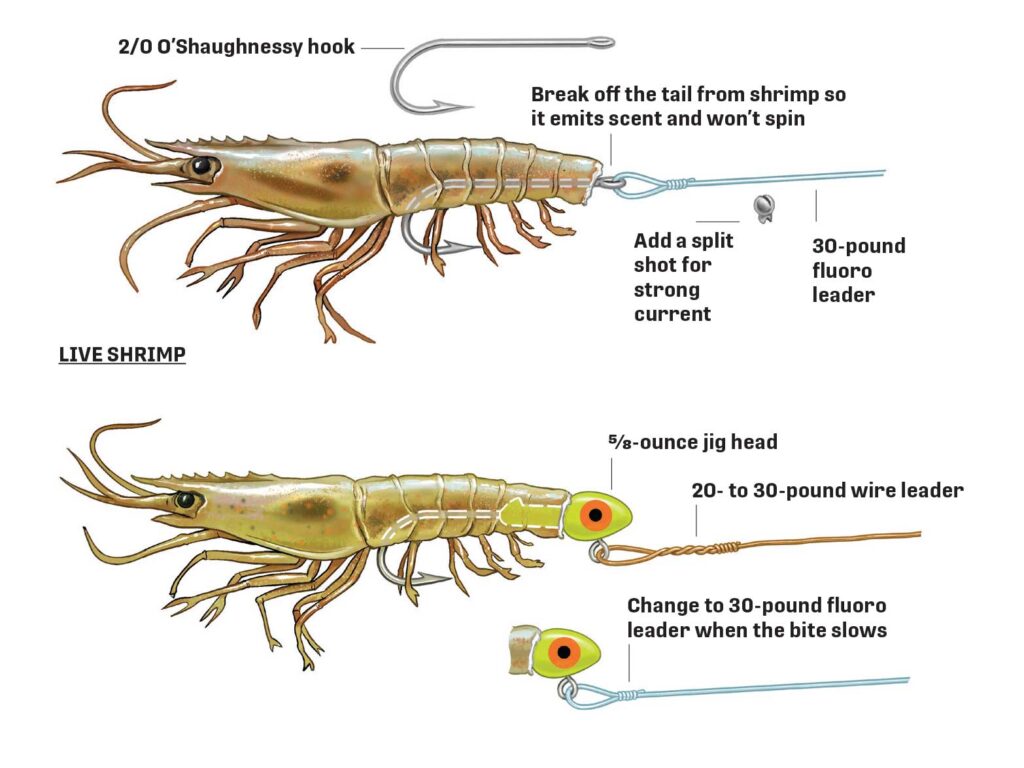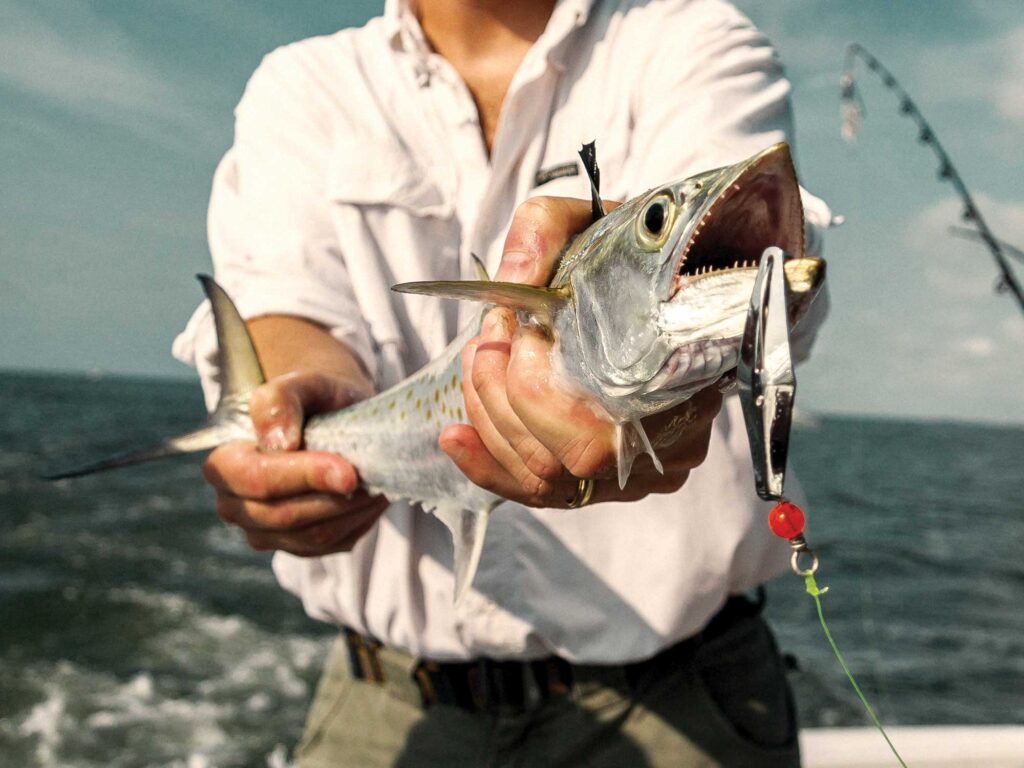Top Spanish Mackerel Fishing Tips
 Double up on Spanish mackerel while you can; eventually, these speedsters get suspicious of wire leaders.
George Poveromo
Double up on Spanish mackerel while you can; eventually, these speedsters get suspicious of wire leaders.
George Poveromo
Florida anglers, especially those in the Florida Keys, can practically set their watches to the start of the Spanish mackerel run. Once water temperatures drop into the low 70s, staggering quantities invade Florida Bay. Materializing by December, they’ll remain through May, barring a warm winter. After Florida, Spanish mackerel head to North Carolina in April, then as far north as Massachusetts in June.
Catching Spanish mackerel in Florida Bay involves anchoring in very shallow waters, hanging a chum block over the side, and drifting back live baits—shrimp in particular. Once chummed into feeding frenzies, they’re easily fooled with artificials. To be clear, try chumming anywhere Spanish mackerel gather, not just Florida.
The Islamorada BoysThis past winter, I fished for Spanish mackerel at Sprigger Bank with Capt. Jim Willcox. We left from Islamorada and made the approximate 14-mile run west. Accounting for the tide, waters here shallow up from 8 feet to about 3 feet by the bank. As easy as Spanish mackerel fishing can be, reading the water makes a hefty difference in the results.
“Clean water and a tide moving in the same general direction as the wind are key,” says Capt. Richard Stanczyk, of Bud N’ Mary’s Marina. Stanczyk has a lot of history chasing Florida Bay mackerel, and I had the opportunity to fish with him a few years ago. Faced with roiled-up waters from a persistent 15-knot wind, Stanczyk painstakingly searched for the cleanest vein of dirty water. As luck would have it, we found one. Deploying a chum bag a few minutes prior to anchoring helps spread scent over the immediate area and shorten the wait time for mackerel.
Spanish mackerel are aggressive strikers of fast-moving lures, spoons and live baits. However, given the Florida Bay run, a live shrimp is king. Stanczyk explained that these mackerel are gorging on Florida Bay’s abundant winter shrimp populations; so much so, they’ll often selectively feed just on them. It’s a similar scenario in Miami’s Biscayne Bay during winter.
When I fished with Stanczyk or Willcox, we sweetened the chum slick with pieces of shrimp. The shrimp scent permeated the immediate area along with the frozen block of chum to draw in and hold the macks. With Stanczyk, we scored Spanish and cero mackerel, the latter mainly an oceanside fish. With Willcox, it was strike after strike from Spanish mackerel until our live shrimp were depleted.
 A shrimp-tipped 5/8-ounce jig head is a deadly mackerel bait.
Steve Sanford
The Leader Gamble
A shrimp-tipped 5/8-ounce jig head is a deadly mackerel bait.
Steve Sanford
The Leader Gamble
Despite the competition among large numbers of Spanish mackerel, they wise up after a bit. Initially, a 20- to 30-pound wire leader works. However, once the aggressiveness tapers off, start experimenting with leaders and hooks.
A shrimp-tipped 5/8-ounce jig head is a deadly mackerel bait. The additional weight increases casting distances and sinks easily in strong currents. When the jig-and-wire-leader bites cool, change to 30-pound mono or fluorocarbon leader. The uptick in strikes should be dramatic—just be quick on the hook-set to keep the mackerel’s jaws from the leader. Rest assured, a fair number of your jigs will be cut off, but you’ll ultimately box more fish.
A time-tested alternative for fooling leery mackerel is a long-shank hook. For example, I’ll use a 2/0 O’Shaughnessy-style hook tied to 30-pound fluorocarbon leader. I prefer fluorocarbon because it’s more abrasion-resistant than mono. Given a light wind and tide, a live shrimp impaled onto a 2/0 O’Shaughnessy hook sinks slowly. With a challenging wind or current, add a split-shot sinker in front of the hook. The long hook shank acts as a wire and protects the light leader. However, here too some cutoffs will occur. Keep a box of 2/0 hooks on the console.
Subtleties that make a difference during a slow bite or with fewer mackerel around include twitching your baits to mimic a shrimp kicking. Mackerel pick up on scent but sometimes need a visual tease to push them over the edge.
Read Next: Best Lures for Spanish Mackerel
 Trolling a spoon is one of the fastest ways to locate Spanish mackerel. Once you find them, get out the shrimp and chum.
Jonathan/stock.adobe.com
Prepare for Different Conditions
Trolling a spoon is one of the fastest ways to locate Spanish mackerel. Once you find them, get out the shrimp and chum.
Jonathan/stock.adobe.com
Prepare for Different Conditions
Floating grass is often problematic in Florida Bay. If so, time the passages of scattered grass clumps and then pitch a bait into a patch of clean water. Next, use the rod tip to steer the line around the floating grass. It’s a lot of work and frustration when fishing in grassy conditions, but if you put in the time necessary, you’ll definitely catch fish.
If floating vegetation isn’t problematic, try trolling a drone spoon, Rapala plug or small yellow feather on 30-pound fluorocarbon leader to locate mackerel. This is also a good idea when you relocate to a new spot. When in these shallow waters, keep your rod tips high and maintain enough speed to keep the lures off the bottom.
As mentioned, Spanish mackerel can be chummed up and taken on topwater plugs, swimming lures like Rapala’s Twitchin’ Mullet, and even on flies. If you’ve got live pilchards in your baitwell, toss out several of them into the slick, followed by a well-placed lure once a blitz begins. On my trip with Stanczyk, he had them hyped up on live shrimp and cut pieces. Still, I caught a few on lures.
Beyond Florida BayAs Spanish mackerel migrate into different waters, the tactics used to catch them vary. For example, Florida Bay represents a shallow-water bay fishery. The Atlantic-run fish, by comparison, are often taken by running the beach and locating schools. Once found, anglers can cast spoons, feathers, or even live baits. Anchoring and chumming on depressions, drops and tight bottom contours off the beach works too, with small live baits like pilchards and shrimp getting the nod. Often when there’s an abundance of a specific forage, as occurs along Florida’s west coast, that bait will yield top results. Trolling in clean water is also effective wherever Spanish mackerel are found.
The post Top Spanish Mackerel Fishing Tips appeared first on Salt Water Sportsman.
- Home
- About Us
- Write For Us / Submit Content
- Advertising And Affiliates
- Feeds And Syndication
- Contact Us
- Login
- Privacy
All Rights Reserved. Copyright , Central Coast Communications, Inc.